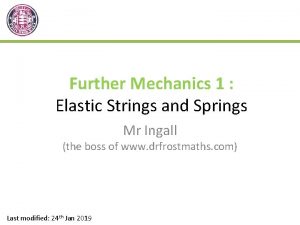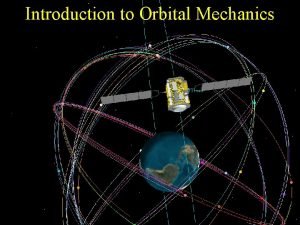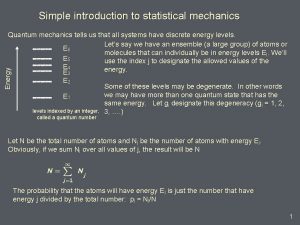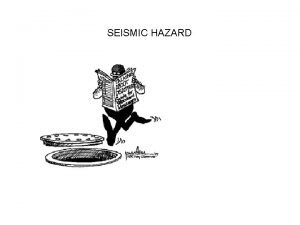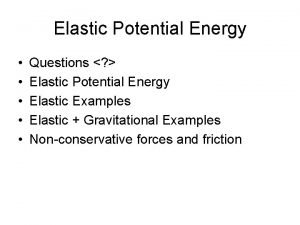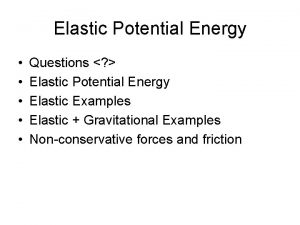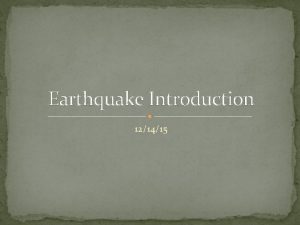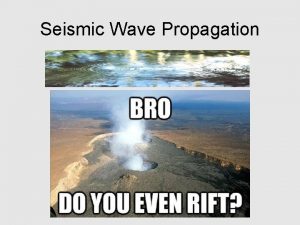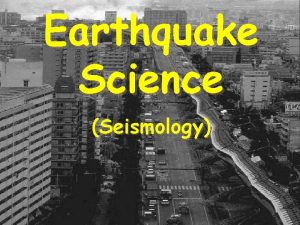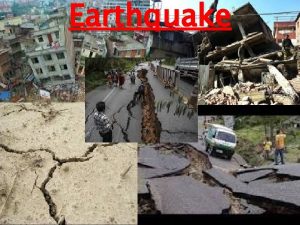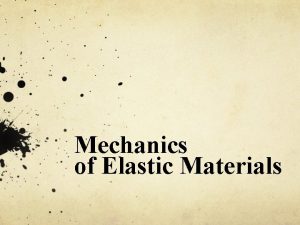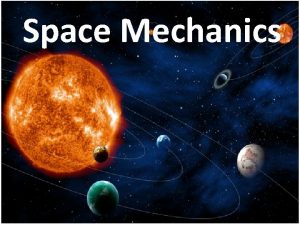INTRODUCTION TO EARTHQUAKE MECHANICS The seismic cycle Elastic

















- Slides: 17

INTRODUCTION TO EARTHQUAKE MECHANICS: • The seismic cycle • Elastic rebound theory The simplistic view is too simple…

The elastic rebound theory (according to Raid, 1910)

The spring-slider analog

Frictional instabilities The common notion is that earthquakes are frictional instabilities. • The condition for instability is simply: • The area between B and C is equal to that between C and D.

Frictional instabilities governed by static-kinetic friction The static-kinetic (or slipweakening) friction: experiment stress Constitutive law static friction kinetic friction Lc Ohnaka (2003) slip

What are the conditions for instabilities in the spring-slider system? stress The static-kinetic friction: static friction kinetic friction Lc Thus, the condition for instability is: slip

Slip Stress Frictional instabilities governed by static-kinetic friction Time

The Parkfield example A sequence of magnitude 6 quakes have occurred in fairly regular intervals. Magnitude 2004 Year The next magnitude 6 quake was anticipated to take place within the time frame 1988 to 1993, but ruptured only on 2004.

So the occurrence of major quakes is non-periodic - why?

The role of stress transfer Every earthquake perturb the stress field at the site of future earthquakes. Animation from the USGS site

The effect of a stress step The effect of a stress perturbation is to modify the timing of the failure according to: That means that the amount of time advance (or delay) is independent of when in the cycle the stress is applied.

A 0 -D spring-slider system is too simple… • Fault networks are extremely complex. • More complex models are needed. • In terms of spring-slider system, we need to add many more springs and sliders. Figure from Ward, 1996

System of two blocks During static intervals: During dynamic intervals: To simplify matters we set: • • • We define: Several situations:

System of two blocks Next we show solutions for: symmateric ( ) Turcotte, 1997 asymmateric ( ) Were: Breaking the symmetry of the system gives rise to a chaotic behavior.

Frictional instabilities in the lab • Frictional instabilities are commonly observed in lab experiments and are referred to as stick-slip. • Note that the occurrence of stick-slip in the lab is non-periodic as well! Brace and Byerlee, 1966

Summary 1 st part • Single spring-slider systems governed by either static-kinetic, or rate- and state-dependent friction give rise to periodic earthquakelike episodes. • The effect of stress change on the system is to modify the timing of the instability. For a fault governed by static-kinetic friction, the time advance depends linearly on the magnitude of the stress step and the stressing rate. • Breaking the symmetry of two spring-slider system results in a chaotic behavior. • If such a simple configuration gives rise to a chaotic behavior what are the chances that natural fault networks are predictable? ? ?

Recommended reading • Scholz, C. , Earthquakes and friction laws, Nature, 391/1, 1998. • Scholz, C. H. , The mechanics of earthquakes and faulting, New. York: Cambridge Univ. Press. , 439 p. , 1990. • Turcotte, D. L. , Fractals and chaos in geology and geophysics, New-York: Cambridge Univ. Press. , 398 p. , 1997.
 Lacunae in bone
Lacunae in bone Spring problems mechanics
Spring problems mechanics Earthquake cycle
Earthquake cycle Earthquake introduction
Earthquake introduction What is an orbit? *
What is an orbit? * Introduction to quantum statistical mechanics
Introduction to quantum statistical mechanics Hình ảnh bộ gõ cơ thể búng tay
Hình ảnh bộ gõ cơ thể búng tay Frameset trong html5
Frameset trong html5 Bổ thể
Bổ thể Tỉ lệ cơ thể trẻ em
Tỉ lệ cơ thể trẻ em Voi kéo gỗ như thế nào
Voi kéo gỗ như thế nào Chụp phim tư thế worms-breton
Chụp phim tư thế worms-breton Hát lên người ơi
Hát lên người ơi Môn thể thao bắt đầu bằng từ đua
Môn thể thao bắt đầu bằng từ đua Thế nào là hệ số cao nhất
Thế nào là hệ số cao nhất Các châu lục và đại dương trên thế giới
Các châu lục và đại dương trên thế giới Cong thức tính động năng
Cong thức tính động năng Trời xanh đây là của chúng ta thể thơ
Trời xanh đây là của chúng ta thể thơ

